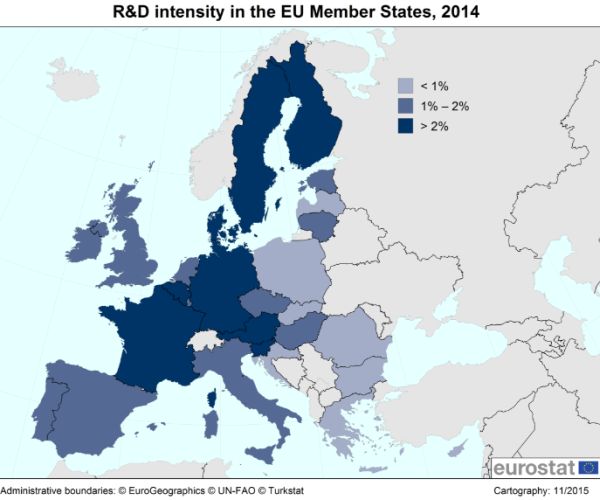Analytics, Education and Science, EU – Baltic States, GDP, Investments, Technology
International Internet Magazine. Baltic States news & analytics
Tuesday, 23.04.2024, 09:20
EU states’ research efforts are lagging behind
 Print version
Print version
In order to provide a stimulus to the EU’s competitiveness, an increase by 2020 of the R&D intensity to 3% in the EU is one of the five headline targets of the Europe 2020 strategy.
The business enterprise sector continues to be the main sector in which R&D expenditure was spent, accounting for 64% of total R&D conducted in 2014, followed by the higher education sector (23%), the government sector (12%) and the private non-profit sector (1%).

With respect to other major economies, R&D intensity in the EU was much lower than in South Korea (4.15% in 2013) and Japan (3.47% in 2013) and lower than in the United States (2.81% in 2012), while it was about the same level as in China (2.08% in 2013) and higher than in Russia (1.15%).
R&D intensity above 3% is only in the Nordic EU member states
In 2014, the highest R&D intensities were recorded in Finland (3.17%), Sweden (3.16%) and Denmark (3.08%), all with R&D expenditure above 3% of GDP, closely followed by Austria (2.99%) and Germany (2.84%). Belgium (2.46%), Slovenia (2.39%) and France (2.26%) registered R&D expenditure above 2% of GDP.
At the opposite end of the scale, nine Member States recorded an R&D intensity below 1%: Romania (0.38%), Cyprus (0.47%), Latvia (0.68%), Croatia (0.79%), Bulgaria (0.80%), Greece (0.83%), Malta (0.85%), Slovakia (0.89%) and Poland (0.94%). Compared with 2004, R&D intensity increased in twenty-three Member States, decreased in Croatia (from 1.03% in 2004 to 0.79% in 2014), Luxembourg (from 1.62% to 1.24%), Finland (from 3.31% to 3.17%) and Sweden (from 3.39% to 3.16%), and remained stable in Romania.
Highest R&D spending is in the business sector in Slovenia, Ireland, Belgium and Austria. The main sector in which R&D was performed in 2014 was the business enterprise sector in all Member States, except Estonia, Greece, Cyprus, Latvia, Lithuania (where the higher education sector was the dominant performing sector) and Romania (where almost half of R&D expenditure was conducted within the government sector).
The highest shares of R&D expenditure performed in the business sector were observed in Slovenia (77%), Ireland (73%), Hungary (72%), Belgium and Austria (both 71%), Germany and Finland (both 68%), Sweden (67%), Bulgaria and France (both 65%), Denmark and the United Kingdom (both 64%). Compared with 2004, the share of R&D conducted in the business enterprise sector increased in sixteen Member States, while it decreased in twelve.
R&D
R&D is highest in the government sector in Romania; the higher education sector in Cyprus and Lithuania has the highest proportion.
For the government sector, the highest share was registered in Romania (43%), followed at a distance by Luxembourg (29%), Slovakia (28%), Greece (27%), Croatia (26%), Bulgaria (25%), Latvia and Poland (both 24%).
The highest shares of R&D conducted within the higher education sector were recorded in Cyprus and Lithuania (both 53%), Portugal (45%), Estonia (44%), Latvia (41%) and Greece (38%).
Research and development expenditure, 2004 and 2014 (firs two in %; last two in mln €)
|
Denmark |
2.42 |
3.08 |
4 897 |
7 952 |
|
|
|
|
|
|
|
Latvia |
0.40 |
0.68 |
47 |
163 |
|
Lithuania |
0.75 |
1.02 |
137 |
370 |
|
Estonia |
0.85 |
1.46 |
83 |
286
|
|
Finland |
3.31 |
3.17 |
5 253 |
6 512 |
|
Sweden |
3.39 |
3.16 |
10 426 |
13 612 |
http://ec.europa.eu/eurostat/web/products-press-releases/-/9-30112015-AP








 «The Baltic Course» Is Sold and Stays in Business!
«The Baltic Course» Is Sold and Stays in Business!

